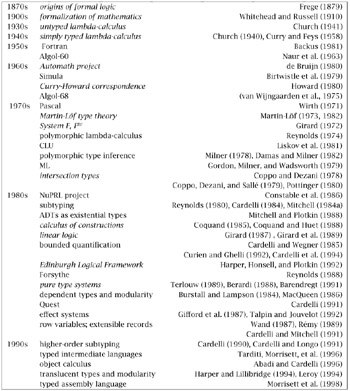1.4 Capsule History
|
| < Free Open Study > |
|
1.4 Capsule History
In computer science, the earliest type systems were used to make very simple distinctions between integer and floating point representations of numbers (e.g., in Fortran). In the late 1950s and early 1960s, this classification was extended to structured data (arrays of records, etc.) and higher-order functions. In the 1970s, a number of even richer concepts (parametric polymorphism, abstract data types, module systems, and subtyping) were introduced, and type systems emerged as a field in its own right. At the same time, computer scientists began to be aware of the connections between the type systems found in programming languages and those studied in mathematical logic, leading to a rich interplay that continues to the present.
Figure 1-1 presents a brief (and scandalously incomplete!) chronology of some high points in the history of type systems in computer science. Related developments in logic are included, in italics, to show the importance of this field's contributions. Citations in the right-hand column can be found in the bibliography.

Figure 1-1: Capsule History of Types in Computer Science and Logic
|
| < Free Open Study > |
|
EAN: 2147483647
Pages: 262